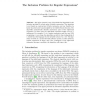Free Online Productivity Tools
i2Speak
i2Symbol
i2OCR
iTex2Img
iWeb2Print
iWeb2Shot
i2Type
iPdf2Split
iPdf2Merge
i2Bopomofo
i2Arabic
i2Style
i2Image
i2PDF
iLatex2Rtf
Sci2ools
LATA
2010
Springer
2010
Springer
The Inclusion Problem for Regular Expressions
This paper presents a new polynomial-time algorithm for the inclusion problem for certain pairs of regular expressions. The algorithm is not based on construction of finite automata, and can therefore be faster than the lower bound implied by the Myhill-Nerode theorem. The algorithm automatically discards unnecessary parts of the right-hand expression. In these cases the right-hand expression might even be 1ambiguous. For example, if r is a regular expression such that any DFA recognizing r is very large, the algorithm can still, in time independent of r, decide that the language of ab is included in that of (a+r)b. The algorithm is based on a syntax-directed inference system. It takes arbitrary regular expressions as input, and if the 1-ambiguity of the right-hand expression becomes a problem, the algorithm will report this.
| Added | 02 Mar 2010 |
| Updated | 15 Dec 2010 |
| Type | Conference |
| Year | 2010 |
| Where | LATA |
| Authors | Dag Hovland |
Comments (0)

